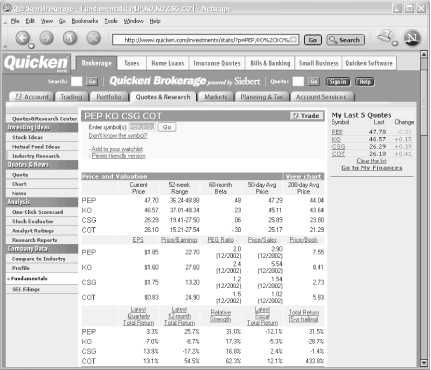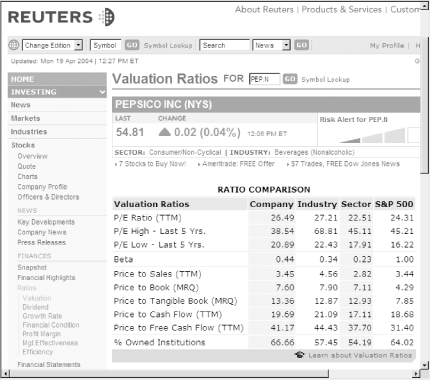A beauty pageant with only one contestant isn’t likely to find the most talented or congenial individual. Likewise with stocks—before you invest, judge your candidate against several of its peers.
Long-term investors often approach their stock selections with the mantra, “Invest in the best.” High-quality, well-managed companies will frequently be the best buy-and-hold investments in your portfolio. By comparing several competitors in the same industry, you can identify the strongest contenders. Another reason to pay attention to a company’s competition is that many financial ratios vary based on the characteristics of each industry. By comparing a company’s financial ratios to those of the competition, you can identify the company’s strengths and weaknesses, and perhaps find a better prospect for your portfolio.
There are two ways to compare a stock to its rivals:
Compare a contender directly to one of its competitors, particularly if the challenger is a leader in its industry. If the stock you’re studying doesn’t measure up, then it might be best to pass over that company—and perhaps take a closer look at the challenger instead.
Compare a stock’s financial results to the averages for its industry. When a company compares unfavorably to the industry average, you can do more research to understand why the company differs from the norm. If the stock is of below average caliber in a number of areas, it’s often better to look for another company. By researching a company’s numbers that exceed industry averages, you can better understand just why the company is an industry leader.
The quickest way to compare a company with its competition, appropriately enough, is to visit Quicken.com (http://www.quicken.com). Armed with a stock you’re studying, type the ticker symbol in the Enter Symbol box and click Go. On the stock’s Quote page under the Company Data heading in the left navigation bar, click Compare to Industry. The Compare to Competitors page displays a list of several competitors. You can type additional ticker symbols in the ticker box in Section 1, or check the checkboxes in Section 2 for each competitor that you want to use. If you don’t see a competitor that you want, click the Show All Competitors link underneath the competitor table.
Select the Fundamentals option in Section 3 for the master view—a whopping 70 different criteria for each company. After you choose the competitors you want to use, click Compare to view the information for each of them. The comparison table displays the measures for each competitor, one below the next, as shown in Figure 4-19. If you prefer graphical comparisons, click the View chart link at the top of a category.
There’s a lot of information in the Quicken.com comparison table. To digest this information, the best approach is somewhat old-fashioned—print the table, then circle the company that leads for each criterion. The company that’s circled the most wins!
Reuters Investor (http://investor.reuters.com) provides an easy way to compare a company against industry and sector averages, as illustrated in Figure 4-20. After you type a ticker symbol in the Symbol box and click Go, click Ratios in the navigation bar. By default, valuation ratios such as the P/E ratio appear in a table next to the average values for the company’s industry, sector, and the S&P 500. In the navigation bar, you can view other ratios by choosing any of the seven ratio categories: Valuation, Dividend, Growth Rate, Financial Condition, Profit Margin, Management Effectiveness, and Efficiency.
Tip
In addition to the ratio comparisons, the Reuters Investor stock page includes a Risk Alert rating that’s hard to ignore. Reuters assigns each company a low, medium, or high risk, based on the number of tests it passes or fails. However, the Risk Alert rating doesn’t test a company’s fundamental measures for risk. It uses estimate revisions, analyst recommendations, institutional selling, shorted shares, price deterioration, and price momentum. It’s better to use your own judgment of a company’s risk [Hack #37] after you’ve evaluated its fundamentals.
Be on the lookout for values that diverge significantly from the industry average. When a company is below the industry average, you must dig into the cause, whereas a positive variation can point out a company’s strengths.
Tip
In addition to industry averages, some data providers calculate sector averages. A sector is a broader classification, but might be too broad to make meaningful comparisons in many cases. For instance, the Utilities sector includes three industry groups: Electric, Natural Gas, and Water utilities. Because of the differences in those industries, comparing an electric utility to a water company or to sector averages won’t necessarily help you determine the strongest stock in an industry.
To really dig into a company’s position in its industry or to better understand its business, seek out trade publications and web sites aimed at people involved in that industry. Although content on these sites is sometimes restricted to subscribers, many sites have public articles and analyses that are quite informative. A finely tuned search at Google.com can turn up plenty of resources for particular industries and sectors. For instance, Bio.com (http://www.bio.com) is a clearinghouse for information on the biotechnology sector. Silicon Investor (http://www.siliconinvestor.com) hosts discussion forums for technology investors, and Gas.com (http://www.gas.com) has links and news about the natural gas industry.
Dow Jones Indexes (http://www.djindexes.com)
Standard & Poor’s Indexes (http://www.spglobal.com)
Yahoo! Industry Center (http://biz.yahoo.com/ic)
—Douglas Gerlach
Get Online Investing Hacks now with the O’Reilly learning platform.
O’Reilly members experience books, live events, courses curated by job role, and more from O’Reilly and nearly 200 top publishers.



